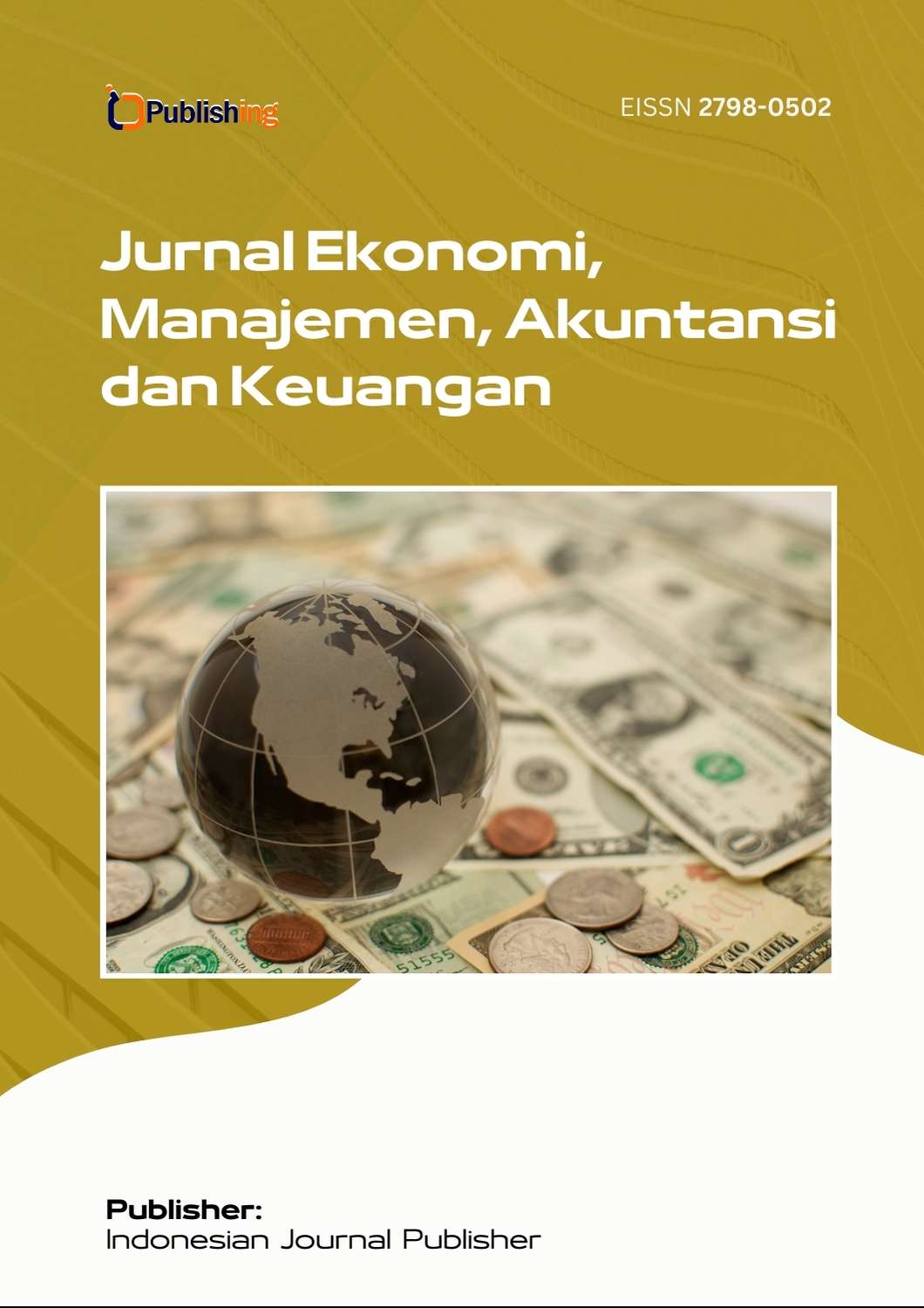Achievement Of Indonesian Sustainable Development Using Multimoora Analysis
DOI:
https://doi.org/10.53697/emak.v6i3.2464Keywords:
Sustainable Development, Human Development, Environment, MultimooraAbstract
Sustainable development is a global concept that has become a priority for every country, including Indonesia. As a vast archipelagic nation with diverse regions, Indonesia presents a unique case study in the implementation of sustainable development. One of the key challenges faced by Indonesia is the uneven distribution of development, which tends to be concentrated around major urban centers such as the capital city, while peripheral regions often lag behind. The essence of sustainable development lies in the internalization of environmental, social, and economic impacts in every policy and action taken. It emphasizes the need to ensure that current development efforts do not compromise the ability of future generations to meet their needs. This study employs the MULTIMOORA (Multi-Objective Optimization by Ratio Analysis plus Full Multiplicative Form) analytical technique to evaluate Indonesia’s sustainable development performance. The results demonstrate significant progress in 2022, where Indonesia ranked first across all three MULTIMOORA methods, marking an improvement from third place in 2021. This upward trend indicates the country’s growing commitment to sustainable development principles. The Sustainable Development Goals (SDGs) serve as comprehensive frameworks that provide specific targets and indicators, which are essential in measuring the effectiveness of development initiatives. By aligning national policies with the SDGs, Indonesia can ensure more inclusive, equitable, and environmentally conscious growth. Sustainable development requires that every social and economic activity accounts for its environmental impact to ensure that natural ecosystems can continue to support life—both now and in the future—thus preserving the planet for generations to come.
Downloads
References
Adah, A. E., Isik, Z., & Tus, A. (2016). The multi-objective decision making methods based on MULTIMOORA and MOOSRA for the laptop selection problem. Journal of Industrial Engineering International, 12(1), 1–9. https://doi.org/10.1007/s40092-015-0121-5
Azis, I. J., Napitupulu, L. M., Patunru, A., & Reksosudarmo, B. (Eds.). (2010). Pembangunan berkelanjutan: Peran dan kontribusi Emil Salim. Jakarta: Perpustakaan Populer Gramedia.
Bappenas, & BPS. (2020). Rencana Pembangunan Jangka Menengah Nasional (RPJMN) 2020–2024. Jakarta: Kementerian Perencanaan Pembangunan Nasional/Bappenas dan Badan Pusat Statistik.
Brauers, W. K. M., & Zavadskas, E. K. (2012). Robustness of MULTIMOORA: A method for multi-objective optimization. Informatica, 23(1), 1–25.
Brundtland Commission. (1987). Our common future. Oxford: Oxford University Press.
Budimanta, A. (2005). Continuing development in urban areas through sustainable development. In Anthology of Indonesian Urban Development in the 2nd Century. Jakarta: Ministry of Public Works.
Djajadiningrat, S. T. (1992). Konsep pembangunan berkelanjutan dalam membangun tanpa merusak lingkungan. Jakarta: Kantor Menteri Negara Lingkungan Hidup.
Faculty of Economics and Business, Mulawarman University.
Fauzi, A. (2014). Valuasi ekonomi dan penilaian kerusakan sumber daya alam dan lingkungan. Bogor: IPB Press.
Görener, A., Dinçer, H., & Hacıoğlu, Ü. (2013). Application of Multi-Objective Optimization on the Basis of Ratio Analysis (MOORA) Method for Bank Branch Location Selection. International Journal of Finance & Banking Studies, 2(2), 41–52.
Hadad, I. (2010). Gerakan lingkungan hidup dan advokasi untuk pembangunan berkelanjutan. In I. J. Azis et al. (Eds.), Pembangunan berkelanjutan: Peran dan kontribusi Emil Salim (pp. 97–112). Jakarta: Perpustakaan Populer Gramedia.
Hafezalkotob, A., Hafezalkotob, A., Liao, H., & Herrera, F. (2019). A new MULTIMOORA method based on Shannon entropy for multi-criteria decision-making problems with interval-valued intuitionistic fuzzy information. Applied Soft Computing, 81, 105501. https://doi.org/10.1016/j.asoc.2019.105501
Pasang, H. (2011). Studi awal dampak kerusakan lingkungan dan perubahan iklim di Indonesia. Jurnal Analisis CSIS, 40(4), 451–470.
IUCN, UNEP, & WWF. (1993). Caring for the Earth: A strategy for sustainable living. Jakarta: PT Gramedia Pustaka Utama.
Kementerian Lingkungan Hidup. (2009). Undang-Undang Republik Indonesia Nomor 32 Tahun 2009 tentang Perlindungan dan Pengelolaan Lingkungan Hidup. Jakarta: Kementerian Lingkungan Hidup.
Kementerian Lingkungan Hidup. (2014). Status lingkungan hidup Indonesia 2014. Retrieved from http://www.indonesia.go.id/../266-kementerian-environmental-life.html
Lele, S. (1991). Sustainable development: A critical review. World Development, 19(6), 607–621.
Meadows, D. H., Meadows, D. L., Randers, J., & Behrens III, W. W. (1972). The limits to growth. New York: Universe Books.
Meiki, P. (2018). Analisis pembangunan berkelanjutan di Indonesia. In Prosiding Seminar Nasional Fakultas Ekonomi dan Bisnis, Universitas Mulawarman.
Ministry of Environment. (2014). Indonesia's environmental status 2014. Retrieved on May 2, 2015 from www.indonesia. go.id/../266-kementerian-environmental-life.html
Pearce, D. W., & Warford, J. J. (1993). World without end: Economics, environment, and sustainable development. New York: Oxford University Press.
Rassanjani, A. (2018). Perencanaan pembangunan berkelanjutan: Evaluasi kebijakan dan implementasi SDGs di Indonesia. Jakarta: LP3ES.
Redclift, M. (2005). Sustainable development (1987–2005): An oxymoron comes of age. Sustainable Development, 13(4), 212–227.
Sachs, J. D. (2015). The age of sustainable development. New York: Columbia University Press.
Sachs, J. D., & Schmidt-Traub, G. (2017). SDG index and dashboards report 2017. New York: Bertelsmann Stiftung and Sustainable Development Solutions Network (SDSN).
Salsabila, A. (2019). Implementasi Rencana Aksi Daerah (RAD) Tujuan Pembangunan Berkelanjutan di Indonesia. Jakarta: Kementerian Perencanaan Pembangunan Nasional/Bappenas.
Sugandi, Y., Darmadji, T., & Sutopo, D. (2007). Prinsip dasar kebijakan pembangunan berkelanjutan yang ramah lingkungan. Jakarta: PT Bumi Aksara.
UNDP. (2015). Transforming our world: The 2030 agenda for sustainable development. New York: United Nations.
United Nations Environment Programme (UNEP). (2011). Towards a green economy: Pathways to sustainable development and poverty eradication. Nairobi: UNEP.
WCED (World Commission on Environment and Development). (1987). Our common future. New York: Oxford University Press.
World Bank. (2012). Inclusive green growth: The pathway to sustainable development. Washington, DC: World Bank Publications.
Zavadskas, K. E., & Brauers, W. K. M. (2012). Robustness of MULTIMOORA: A method for multi-objective optimization. Informatica, 23(1), 1–25.
Downloads
Published
How to Cite
Issue
Section
License
Copyright (c) 2025 Ni Kadek Eka Jayanthi

This work is licensed under a Creative Commons Attribution-ShareAlike 4.0 International License.










